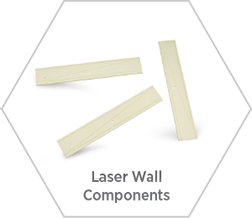
Aluminum Oxide — Al2O3
One of the most robust technical ceramic materials, high-purity aluminas feature enhanced corrosion, low leaching, and superior wear resistance. Microstructures and electrical resistivity can be tuned to specific applications.
Primary Features
- Electrical insulating properties
- Heat resistance
- Wear resistance
- Electrical insulator
- High dielectric strength
- Low dielectric loss
- Corrosion resistance
- Plasma resistance
Applications
- Semiconductor manufacturing
- Medical components
- Electrical insulation
- Wear-resistant components
- Machinery
- Fluid handling


![]()
![]()
![]()
![]()
Materials
- KMT-97 — 97% Al2O3
- KMT-998 — 99.8% Al2O3
- K1-A — 99.8% Al2O3
- KMT-999 — 99.9% Al2O3
Material Properties for KemaTek Aluminas
| Properties | Units | Test | Aluminas Al2O3 | |||
| Material Name | KMT-97 | KMT-998 | K1-A | KMT-999 | ||
| Color | White | Ivory | Ivory | Ivory | ||
| Primary Material Content | 97% Al2O3 | 99.8% Al2O3 | 99.8% Al2O3 | 99.9% Al2O3 | ||
| Characteristics | Metallization, Wear Resistance | Excellent anti-plasma properties, high wear resistance | ||||
| Applications | IC packaging, electronic components, mechanical parts | Semiconductor equipment components, wear and corrosion components | ||||
| Bulk Density | g/cc | ASTM-C20 | 3.70 | 3.92 | 3.92 | 3.95 |
| Water Absorption | % | ASTM-C373 | 0 | 0 | 0 | 0 |
| Vickers Hardness (Load 500 g) | GPa | ASTM-C1327-03 | 13.8 | 17.3 | 18.0 | 18.5 |
| Flexural Strength | MPa | ASTM-C1161-02c | 350 | 350 | 3.50 | 3.50 |
| Compressive Strength | MPa | ASTM-C773 | 2250 | 2450 | 2500 | 2600 |
| Young’s Modulus of Elasticity | GPa | ASTM-C1198-01 | 330 | 360 | 365 | 380 |
| Poisson’s Ratio | — | ASTM-C1198-01 | 0.23 | 0.23 | 0.22 | 0.23 |
| Fracture Toughness | MPa * m12 | ASTM-C1421-01b (Kevron notched beam) | 3 | 4 – 5 | 4 – 5 | 4 – 5 |
| Coefficient of Linear Thermal Expansion, 40-400 ℃ | x 10-6/℃ | ASTM-C372-94 | 7.1 | 8.2 | 8.1 | 8.2 |
| Thermal Conductivity, 20℃ | W/(m • K) | ASTM-C408-88 | 25 | 30 | 32 | 32 |
| Specific Heat | J/(Kg • K) x 103 | ASTM-E1269 | 0.78 | 0.80 | 0.80 | 0.78 |
| Thermal Shock Resistance | ℃ | Note 1 | 200 | 220 | 220 | 220 |
| Volume Resistivity, 20℃ | Ω • cm | ASTM-D257-99 | >1014 | >1015 | >1015 | >1015 |
| Dielectric Strength | KV/mm | ASTM-D149-97 | 16 | 17 | 17 | 17 |
| Dielectric Constant, 1 MHz | — | ASTM-D150-98 (1 MHz) | 9.0 | 9.8 | 9.8 | 9.7 |
| Loss Tangent | (x 10-4 | ASTM-D150-98 (1 MHz) | 3.0 | 1.0 | 1.0 | 1.0 |
| Nitric Acid 60% 90℃ | WT Loss (mg/cm2/day) | — | <0.12 | <0.05 | — | — |
| Sulphuric Acid 95%, 95℃ | WT Loss (mg/cm2/day) | — | <0.30 | <0.23 | — | — |
| Caustic Soda 30%, 95℃ | WT Loss (mg/cm2/day) | — | <0.90 | <0.04 | — | — |

Ceramic Materials Properties Chart — All Materials — PDF, 128K
For more information or to get a quote on your next refurbishment project, please contact us.

